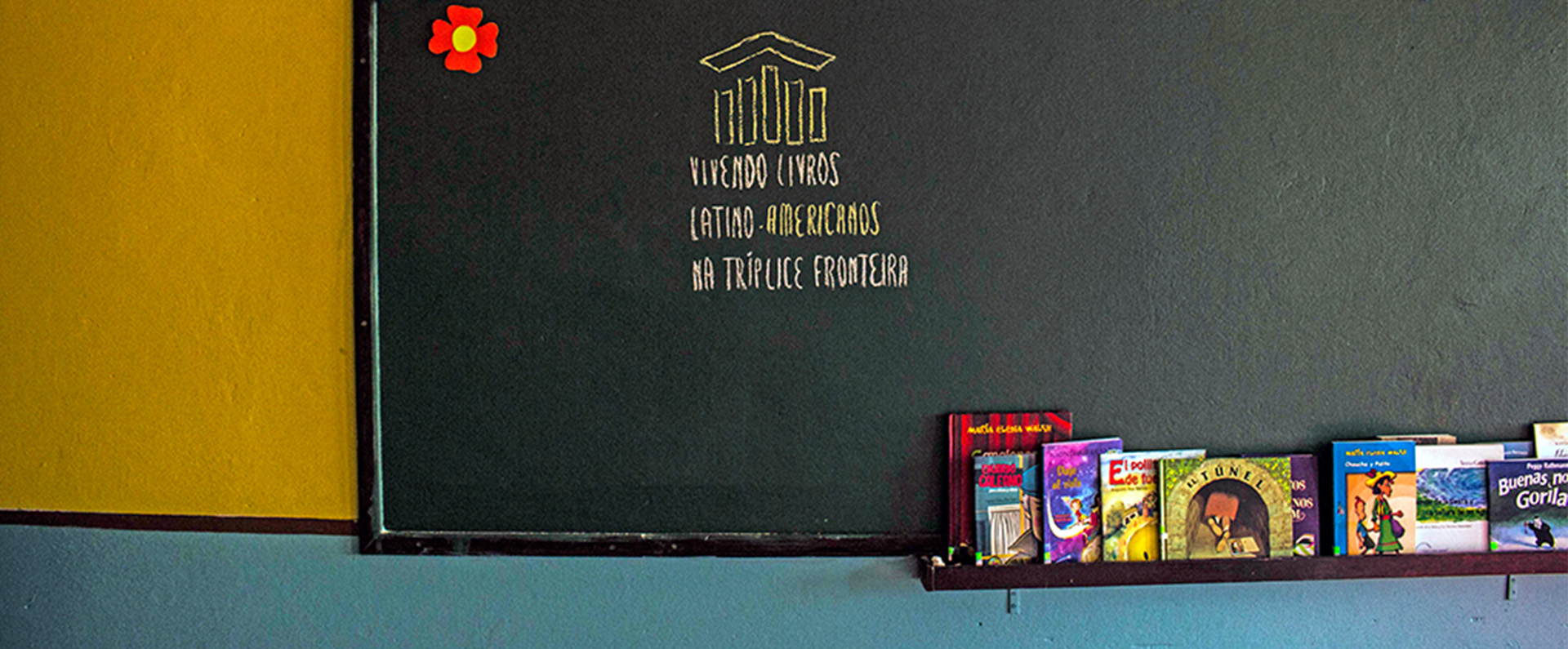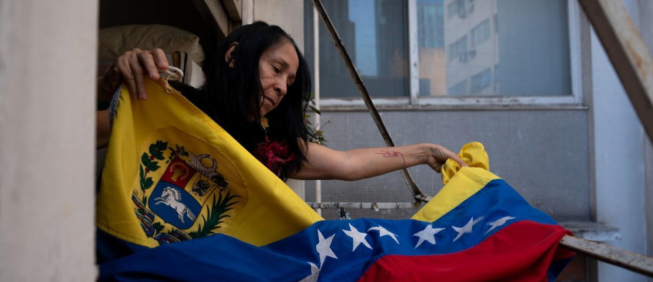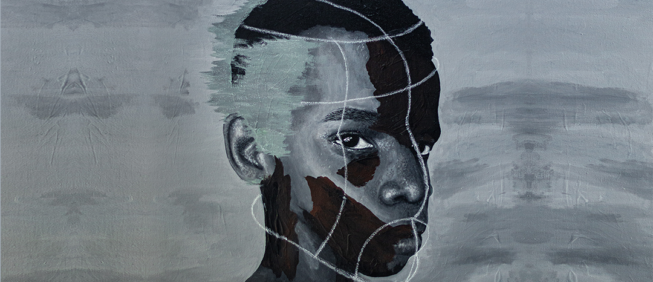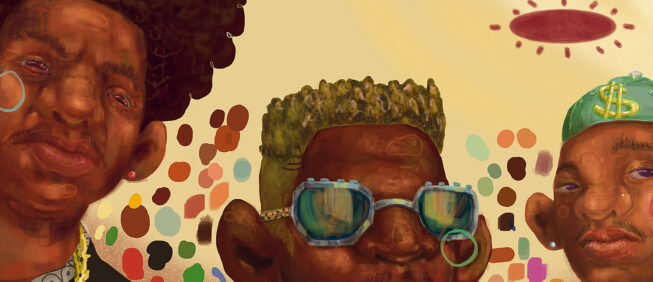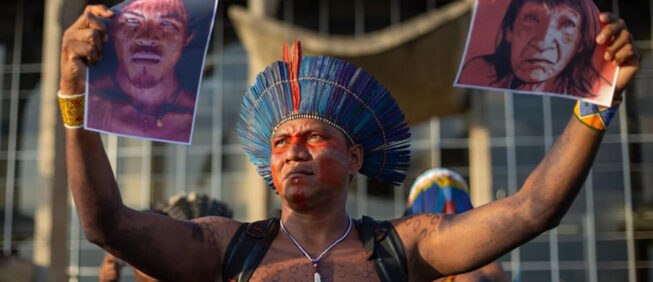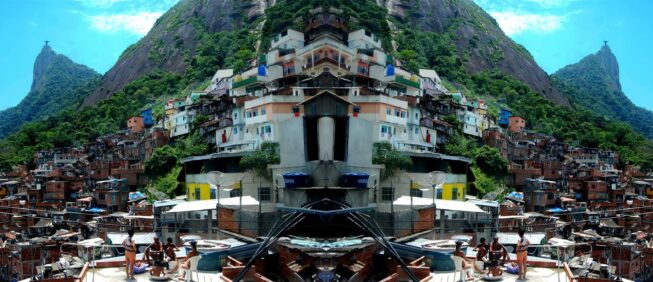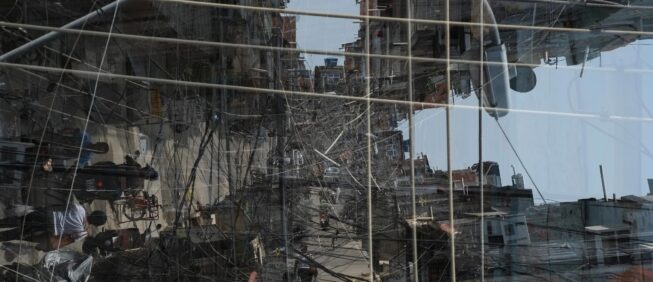Literary conversations in Paraguay: designing paths for re-existence
Mariana Cortez
| Paraguay |
December, 2019
translated by Mark Prunella-Miller
Abstract
With the Living Latin American Books on the Triple Border project (Vivendo Livros latino-americanos na tríplice fronteira), we are working with children that belong to “oral” communities, where writing is not a regular practice and access to written culture is difficult and, thus, still very limited. The goal of this project is to revitalize the spaces intended for books in public schools and propose methods of literary reading mediation with the purpose of training young readers in these communities. “Living books” is nestled in the triple border region (Argentina, Brazil, Paraguay) and, like any border zone, identities are particularly fluid. In transit between the three different countries, the zone is a space of cultural exchanges and tensions.
The original presence of the Guarani communities, sometimes noticeable in the habitants’ [physical] features as traits or predominant markings and, also in the language, comes together in the context of the Living Latin American Books on the Triple Border project. However, due to innumerable historical, social, and linguistic factors, Guarani communities are invisibilized and devalued. In schools along the border, students, teachers, and school administrators are identified by their mixed features. However, it’s also possible to identify the fading of ethnic-cultural traces, as neither in public school teachers’ lessons, nor in their teaching plans are questions of cultural encounters treated as something alive and valued in the territory. In this sense, we understand that, in situations of social interaction, figures maintain and define their ethnic borders in relation to other social groups in view of their interests and positions in certain circumstances.
Camblong (2011), an Argentine researcher who deals with specific issues concerning the triple border, presents the region’s population in the following way:
The collective and individual memory of borders holds and processes a semiotic arsenal of jokes, epithets, arguments, historical, episodical, and legendary narratives as a product of the border’s own frictions. Along the border, differences sustain a myriad of contacts that appear and disappear like lightning, contacts that swell, fleeting in their looks, accents, tones, pronunciation, distances, skin, and hairstyles, clothing and shoes, poses, and gestures. (CAMBLONG, 2011, p.17).
Beyond the inhabitants’ own issues and ways of existing, we must also call into question the physical border—bridge, river, street—as a merely fictitiously demarcated space, dividing nation-states, since residents are in constant flux. Just as in schools, there are people who are the product of marriages between nationalities, those who are natives of indigenous communities and, also, those who have lived part of their lives on one side of the border and part on another, among many other possibilities.
In each of the cities and schools where we work, we find varied contexts, though they share some common characteristics (the fluidity and transit between countries): in Foz do Iguaçu (Brazil), we work at a rural school (lowly populated area where people live off of family farming), in Ciudad del Este (Paraguay), at an urban school (highly populated area, in an occupied region lacking basic sanitation services), while in Puerto Iguazú (Argentina), the school is located in a rural area, today reshaped by tourism (big luxury hotels) and surrounded by three Guarani indigenous communities.
Beyond the outlined diversity, in virtue of the socioeconomic characteristics of the neighborhoods in which we develop our activities, we come across and live with child laborers—be it in the countryside, where they deal with farming and livestock, or in Ciudad del Este, where commerce is a common space for child labor, or in Puerto Iguazú, in hotel services.
In 2014, Living books started its activities at a school in the countryside, in the rural area of Foz de Iguaçu. We quickly understood that the children there wanted to tell [stories] and talk rather than listen to us. We started by telling a story and, in doing so, introduced a certain character, when one of them began right away with - “ohhh do you know that there in my house…” or “Sunday, here in this shed, was the funeral for Mr. João…” or “At my house there is a Brazilian grape tree…” And so continued a lengthy conversation beginning with the book’s narrated story, but full of interventions of experiences narrated by the children themselves. Through these initial mediations, we looked for theoretical sustenance that might help us reflect on these lived experiences.
II
Keeping with other research
Aidan Chambers (2007) defines this narrative practice as “Literary Conversations.” The theorist suggests a focus on something called “Tell me”1Originally Dime in Spanish - a term not yet translated into Portuguese, but for which we propose “Fale-me/Conte-me.” Its purpose is to train the reader for conversation, as literary criticism is nothing more than conversing with and about the text, bridging it with one’s own experiences, daily events, or established connections with other artistic experiences that we have. The educator suggests that literary conversations stem from the following questions: what did you like about the story? What didn’t you like? What surprised (baffled) you? And, what connections can you make?
From the group’s responses arise themes for discussion. These may be matters of ethics, as in our reading of Lygia Bojunga Nunes’ book A Bolsa Amarela (The Yellow Bag) with the children from the countryside school. In that reading, we discussed the difficulty that children have with having their voices heard in family decisions. We made it clear that this was not a theme previously thought about by the group of mediators; it was a desire of the children themselves. Another example: by way of the same work, we discussed the “discomfort” caused by the fate of one of the characters, possibly the most beloved by the class—the King Rooster. In this story, the reader doesn’t know if the rooster actually traveled around the world or if it was a metaphor for his death. Our discussion centered on the quality of the work, because some had said that it wasn’t good, while others identified the possibility of making up an ending, recognizing the story’s literary ambiguity.
Chambers listens to the children’s responses in order to generate themes. This strategy brought us, naturally, to the “Culture Circles,” presented in Education, the practice of freedom (1991), by Paulo Freire. We started to understand the possibility of “Literary Conversation” as a democratic space for discussion, in which each participating subject has a voice to project and to the ability to reflect on his or her arguments. With literary reading actions, we try to approach the “culture circles”—developed horizontally—in which there is, in place of a teacher, a mediator, [or] someone who takes over in a transformational role. This creates an environment for sharing knowledge and doubts, always by means of contact with the Other, in the text, author, illustrator, or peer in the circle. The mediator, in this experience, is a subject who is more active in the process of mediated learning and re-learning, in this case, through literature.
This practice indicates that the mediation of literary readings is intrinsically linked to the culture of the learner and, also, to that of the mediator. Through dialogue there exists an opportunity for knowledge, not by the artificial imposition of wisdom which takes place so often in traditional classrooms.
From Freire, we moved on to “decolonial pedagogy,” here examined through the reflections of Catherine Walsh, an American researcher living in Ecuador. She worked with Paulo Freire, and her ideas are well aligned with his.
Decolonial proposals come from an understanding of the tension in Latin American that isn’t necessarily through class struggle as the Marxists understood, but more specifically, in people’s “traits” from a racial perspective. Walsh ponders that “The colonial matrix affirms the central place of race, racism and racialization as constitutive and founding elements in relations of domination.”2"Más bien, la matriz de la colonialidad afirma el lugar central de raza, racismo y racialización como elementos constitutivos y fundantes de las relaciones de dominación (WALSH, 2012, p.4).
Theorists who share this perspective come to see this question as urgent, thinking of Latin America on its own, with its own conditions, formations and conflicts, rejecting the “white, patriarchal and eurocentric” perspective, valuing as well proposals for solutions that arise from our diversity, affirming that the native peoples are essential to the practice of critical interculturalism, “a construction by and from a people who suffered a history of submission and subordination.”3“una construcción de y desde la gente que ha sufrido una historia de sometimiento y subalternización” (WALSH, 2012, p. 9)
Walsh aligns herself with this perspective and goes on to point out that Frantz Fanon (1979) and Freire are the precursors to this decolonial “turning-point,” or proposal of intercultural criticism. Fanon considered the racial issue and its resulting structure to be fundamental to his reflections. Freire, on the other hand, insisted on class struggle as structuring the ways of being in the world. From the decolonial perspective, the issue of race, as noted above, defines power relations in Latin America and imposes a forced hierarchy on our society. We came to, over time, understand ourselves not through our idiosyncrasies, developed through “listening” to the community, but through what the Other thought of us. And, faced with this provocation, authors like Quijano, Dussel, and Mignolo suggest the “inversion” of the ways we think about territories and their people.
Returning to Walsh, we highlight that she has long worked in indigenous communities in Ecuador and, thus, has listened extensively to these communities. Resulting from this, these communities began to question the concept of “interculturality,” a term which, according to the author, was co-opted by governments that began to “sell” Latin American cultural diversity. These communities, however, understood that it was not enough to make the country’s “cultural diversity” official. It was necessary, above all, to be heard, to occupy decision-making spaces, and retake presence in the halls of power in order to decolonize knowledge.
Official discourses in Latin America welcomed and used the idea of multiculturalism, but one that was inserted in the neoliberal perspective. This idea is widely used, for example, by cosmetic and tourism industries. The decolonial perspective will detect, therefore, that the State appropriates itself through “multicultural marketing,” in which racist tensions are diluted and cultural-ethnic diversity turns into merchandise. The previously mentioned theorists would oppose this, suggesting that only when the communities (of native peoples or of the African diaspora) are heard, will Latin American thought come from us.
III
Plurilingual Conversations
We reaffirm the importance of listening to the community and we exemplify this practice by way of our literary mediation carried out in Paraguay, in Ciudad del Este. It’s good to make clear that we are a “foreign” group to the community, a group that comes from the university and arrives at the school, and that this group is diverse in the languages that we speak—we are Brazilians and Spanish speakers from the triple border region (Argentina, Brazil, Paraguay), but also Colombians, Ecuadoreans, Salavadoreans. Our job is to go to the school space to read with Paraguayan bilingual/plurilingual children (Spanish, Guarani-Jopará, Portuguese…).
The anthropologist Meliá (2012), originally from Spain but rooted in Paraguay, denounces what he calls the “Farce of the Paraguayan bilingualism.” Here, we perceive the exaltation of cultural diversity, in terms criticized by Walsh, affirming that, with the officialization of the two languages, there was the imposition of Spanish in territories previously only inhabited by the Guarani people. He highlights that, often, this ancestral language is limited to the rural areas. Although we believe Meliá’s reflections, we find, even in an urban school in the second largest city in Paraguay, that the language in living spaces and socialization is predominantly a variation of Jopará—that is to say, a mix between Spanish and Guarani. We raise the hypothesis that Guarani-Jopará is present in communities of the lowest socioeconomic stratum and that this localization is the determinant in forming class divisions. We posit that these Guarani language groups occupy territories in the urban area on the outskirts of the city center. In other words, the use of language is intimately linked to racial condition and its subordination, as decolonial authors would suggest.
We analyzed, in this sequence, two situations: the first occurred after the revitalization of the library space. We had a proposal for the creation of an oral narrative archive in Guarani so that the local culture could become part of the library and be available for its users. We went about looking for teachers that might be able to record these histories. As our contact with the school professionals was still very limited, we faced a bit of difficulty, but we understood such a strategy, also, to be an act of approximation. However, in conversations with the teachers, we perceived certain resistance, until one of them cleared it up: “You can ask the Guarani teacher about this. He knows how to speak well, not us.” As we had been in the initial phases of contact, we understood the reply as mistrust in the presence of the university in a neighboring country’s school space.
Now, the second moment is related to the previous one, and offers paths for understanding it: speaking with one of the women teachers about a future project (for the second semester of 2019) in which we would invite sixth grade students to tell stories in Guarani, the teacher explained: “Listen, Guarani is very difficult, you could ask them to tell a story in Jopará. Nobody here in this school knows Guarani well, only the Guarani teacher.”
Through these revelations, it was possible to understand the value that teachers attributed to the two languages: Guarani (an official, “inaccessible,” language of the Other) and Jopará (daily use, undervalued, their language). This teacher was certain that we wouldn’t be interested in her community’s language. Our intention was just the opposite of that imagined: to get to know them, but more than anything, to be with them, not only as objects of study, but to ensure a democratic space for the exchange of knowledge.
It’s worth noting that the children were almost always conscious of the contextual use of the languages, because they interacted with us, primarily, in Spanish. However, our interlocutors, mostly from the perspective of mediators, became particularly unreliable, because the practices of reading out-loud and literary conversations as mediation strategies demand listening. The response is what gives rise to the collective construction of meaning (as we have attempted to establish). The impasse that arises is that, many times, the children’s Spanish is mixed with Guarani and, for our conversations to be effective, we need a minimum of understanding and openness.
This matter became explicit in one of the performed mediations, when children from sixth grade (11 - 14 year-olds) asked us about our stance on their mother tongue. The situation came up during a conversation after the reading of a story in which the protagonists, while unable to speak (a gorilla and a cat), searched for a way to communicate through sign language.
When the story ended, the mediator began to ask each child why the story seemed “beautiful” (making a pun from the name of the book, Little Beauty, by Anthony Browne), the students replied with short sentences, “the cat;” “the cat when it got strong;” or, “I liked the story.” This went on until one of the students replied very quietly and the mediator asked for him to repeat himself, because she hadn’t heard him. He repeated himself, and again she didn’t understand him. The third time, she understood, and everyone began to laugh. “You have to be patient with us,” the mediator replied, and she explained the linguistic issues present in the mediations.
At that moment, another student said something in Guarani to the student who had spoken softly. The mediator ended up, again, not understanding. So, another student translated for her, calming her down. Another student then interrupted, saying: “Speak to her in Guarani,” but the mediator insisted that she wouldn’t understand and asked: “How can I understand you?” The student replied: “I don’t know, just understand.” In other words, he was hoping that, in some way, the mediator would learn or make an effort so that the mediation could happen in his own language. At that moment, a group of students began to attempt to communicate in Guarani with the mediator, and another, in a collaborative way, tried to mediate the situation, translating the sentences from Guarani to Spanish.
IV
Through the described dialogue, it’s possible to understand that the resistance that the adolescents had in relation to the adult, in this case, was clearly due to language. They were aware of the linguistic power and “played” with it. It’s something absolutely normal in the school space—that is, the power struggle between adults (authority) and youth, reproduced in linguistic terms. Given this, it’s possible to infer, in this case, that “shame” or rejection of a mother tongue doesn’t exist. Rather, there is an understanding that, if we want to communicate, the interlocutor must also adapt to the receiving culture. Language, therefore, became a trump card in the negotiation for power relations and demanded a “displacement” on the part of the mediator, given that the issues brought up by the community demanded an approach which was more negotiated and less imposing from a cultural-linguistic point of view. This experience made us redesign everything we had initially planned, and we had to think about proceeding with reading mediation in a plurilingual space. We structured our actions in the second semester of 2019 so that we could establish a horizontal relationship with the class, in which the mediators would tell stories in Spanish and the students would tell stories in Jorpará or another language (not necessarily a verbal language). It was hoped that through this strategy, the mediators would gradually be able to approach this cultural-linguistic context.From the tensions and impasses that came up during the mediations, it was possible to understand that, in intercultural spaces, the focus given to Literary Conversations should give way to a more cultural-linguistic perspective. Thus, the Literary Conversations’ proposal developed by Living Latin American Books on the Triple Border seeks to provide the following:
1) A space to get to know others and recognize yourself, as this way we understand ourselves as mediators and we are understood;
2) A potent environment for creating literary readers;
3) A democratic and liberating space.
Maybe, by providing this environment for democratic listening, we will be able to, with the children, think about school, the library, and books from an “inverse logic,” or in other words, that in which the community itself charts the path for our “Literary Conversations” and, in this interactive space, builds a new way of (re) existing.
CHAMBERS, Aidan. Dime. Los niños, la lectura y la conversación. México: Fondo de Cultura Económica, 2007.
CAMBLONG, A. “Experiências de confines, contactos y mestizajes.” In: Abehache: Revista da Associação Brasileira de Hispanistas – v. 1, n. 1, São Paulo: ABH, 2011.
FANON, Frantz. Os condenados da terra. Trad. José Lourênio de Melo. 2. ed. Rio de Janeiro: Civilização Brasileira, 1979.
FREIRE, P. Pedagogia do Oprimido. Rio de Janeiro: Paz e Terra, ed.62, 2016.
_________Educação como prática da liberdade. 23ª ed. Rio de Janeiro: Paz e Terra, 1999.
MELIÁ, Bartolomeu. “La interculturalidad y la farsa del bilingüismo”. abehache - ano 2 - nº 2 - 1º semestre 2012.
WALSH, Catherine. “Interculturalidad crítica y pedagogía de-colonial: apuestas (des) de el in-surgir, re-existir y re-vivir”. Revista de Educação Técnica e Tecnológica em Ciências Agrícolas, v. 3, n. 6, 2012. (disponível em: http://www.ufrrj.br/SEER/index.php?journal=retta&page=article&op=view&path%5B%5D=1071)

Mariana Cortez | Paraguay |
Language/Linguistcs Professor at the Federal University Integración Latinoamericana (UNILA), PhD in languages by the São Paulo University (USP) and coordinator of the Project Living Books
mariana.cortez@unila.edu.br